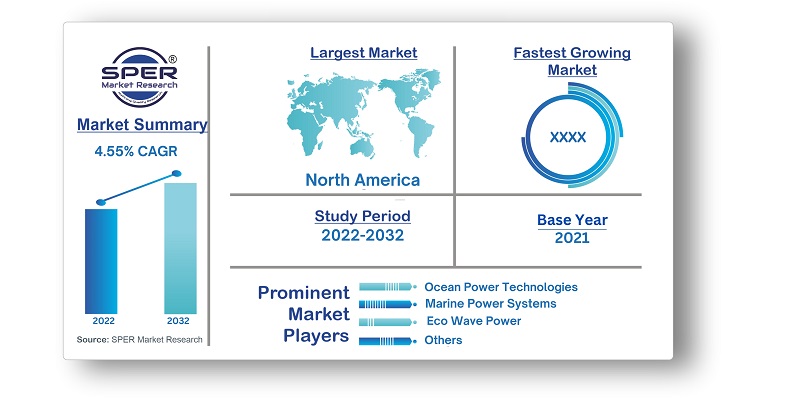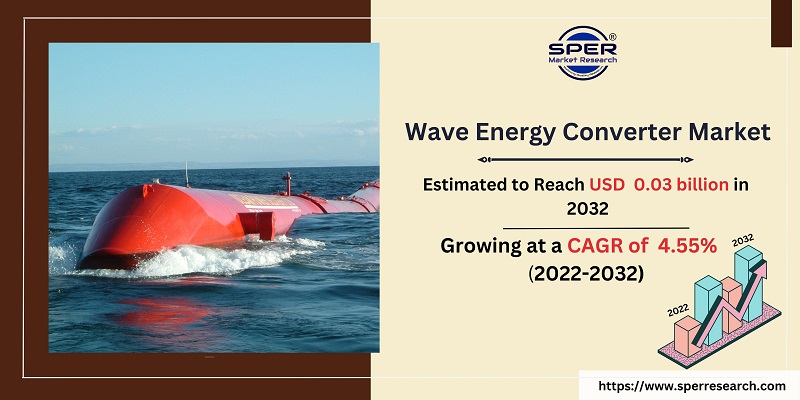
Wave Energy Converter Market Growth, Share, Revenue, Scope, Manufacturers and Future Trends
Wave Energy Converter Market Size- By Type, By Mode of Operation, By Deployment Location, By Take-Off System, By Application- Regional Outlook, Competitive Strategies and Segment Forecast to 2032
| Published: Mar-2023 | Report ID: POAE2324 | Pages: 1 - 234 | Formats*: |
| Category : Power & Energy | |||


| Report Metric | Details |
| Market size available for years | 2019-2032 |
| Base year considered | 2021 |
| Forecast period | 2022-2032 |
| Segments covered | By Type, By Mode of Operation, By Deployment Location, By Take-Off System, By Application |
| Regions covered | Asia-Pacific, Europe, Middle East and Africa, North America, Latin America |
| Companies Covered | Ocean Power Technologies, Marine Power Systems, Eco Wave Power, SINN Power GmbH, NEMOS GmbH, INGINE Inc., Carnegie Clean Energy, AWS Ocean Energy, HavKraft AS, Wave Dragon, Aquanet Power |
- Energy Companies
- Engineering and Construction Firms
- Environmental Organization
- Absorber
- Attenuator Point
- Terminator
- Bulge Wave Devices
- Oscillating Body Converter
- Oscillating Water Column
- Oscillating Wave Surge Converter
- Overtopping Devices
- Rotating Mass Devices
- Submerged Pressure Differential
- Nearshore Devices
- Off-shore Devices
- Shoreline Devices
- Electrical Linear Generator
- Hydraulics
- Turbine Transfer
- Environment Protection
- Power Generation
- Seawater Desalination
- Asia-Pacific
- Europe
- Middle East & Africa
- North America
- Latin America
- Size of Global Wave Energy Converter Market (FY’2019-FY’2032)
- Overview of Global Wave Energy Converter Market
- Segmentation of Global Wave Energy Converter Market By Type (Absorber, Attenuator Point, Terminator)
- Segmentation of Global Wave Energy Converter Market By Deployment Location ( Nearshore Devices, Off-shore Devices, Shoreline Devices)
- Segmentation of Global Wave Energy Converter Market By Take Off System ( Electrical Linear Generator, Hydraulics, Turbine Transfer)
- Segmentation of Global Wave Energy Converter Market By Application ( Environment Protection, Power Generation, Seawater Desalination)
- Growth Analysis of Global Wave Energy Converter Market
- Problems and Challenges in Global Wave Energy Converter Market
- Competitive Landscape in the Global Wave Energy Converter Market
- Details on Recent Investment in Global Wave Energy Converter Market
- Competitive Analysis of Global Wave Energy Converter Market
- Major Players in the Global Wave Energy Converter Market
- SWOT Analysis of Global Wave Energy Converter Market
- Global Wave Energy Converter Market Future Outlook and Projections (FY’2019-FY’2032)
- Recommendations from Analyst
1.1. Scope of the report1.2. Market segment analysis
2.1 Research data source2.1.1 Secondary data2.1.2 Primary data2.1.3 SPER’s internal database2.1.4 Premium insight from KOL’s2.2 Market size estimation2.2.1 Top-down and Bottom-up approach2.3 Data triangulation
4.1. Driver, Restraint, Opportunity and Challenges analysis4.1.1 Drivers4.1.2 Restraints4.1.3 Opportunities4.1.4 Challenges4.2. COVID-19 Impacts of the Global Wave Energy Converter Market
5.1. SWOT analysis5.1.1 Strengths5.1.2 Weaknesses5.1.3 Opportunities5.1.4 Threats5.2. PESTEL analysis5.2.1 Political landscape5.2.2 Economic landscape5.2.3 Social landscape5.2.4 Technological landscape5.2.5 Environmental landscape5.2.6 Legal landscape5.3. PORTER’S five forces analysis5.3.1 Bargaining power of suppliers5.3.2 Bargaining power of Buyers5.3.3 Threat of Substitute5.3.4 Threat of new entrant5.3.5 Competitive rivalry5.4. Heat map analysis
6.1 Global Wave Energy Converter Manufacturing Base Distribution, Sales Area, Product Type6.2 Mergers & Acquisitions, Partnerships, Product Launch, and Collaboration in Global Wave Energy Converter Market
7.1 Absorber7.2 Attenuator Point7.3 Terminator
8.1 Bulge Wave Devices8.2 Oscillating Body Converter8.3 Oscillating Water Column8.4 Oscillating Wave Surge Converter8.5 Overtopping Devices8.6 Rotating Mass Devices8.7 Submerged Pressure Differential
9.1 Nearshore Devices9.2 Off-shore Devices9.3 Shoreline Devices
10.1 Electrical Linear Generator10.2 Hydraulics10.3 Turbine Transfer
11.1 Environment Protection11.2 Power Generation11.3 Seawater Desalination
12.2 Global Wave Energy Converter Market Size and Market Share by Region (2026-2032)12.1 Global Wave Energy Converter Market Size and Market Share by Region (2019-2025)12.3 Asia-Pacific12.3.1 Australia12.3.2 China12.3.3 India12.3.4 Japan12.3.5 South Korea12.3.6 Rest of Asia-Pacific12.4 Europe12.4.1 France12.4.2 Germany12.4.3 Italy12.4.4 Spain12.4.5 United Kingdom12.4.6 Rest of Europe12.5 Middle East and Africa12.5.1 Kingdom of Saudi Arabia12.5.2 United Arab Emirates12.5.3 Rest of Middle East & Africa12.6 North America12.6.1 Canada12.6.2 Mexico12.6.3 United States12.7 Latin America12.7.1 Argentina12.7.2 Brazil12.7.3 Rest of Latin America
13.1 Ocean Power Technologies13.1.1 Company details13.1.2 Financial outlook13.1.3 Product summary13.1.4 Recent developments13.2 Marine Power Systems13.2.1 Company details13.2.2 Financial outlook13.2.3 Product summary13.2.4 Recent developments13.3 Eco Wave Power13.3.1 Company details13.3.2 Financial outlook13.3.3 Product summary13.3.4 Recent developments13.4 SINN Power GmbH13.4.1 Company details13.4.2 Financial outlook13.4.3 Product summary13.4.4 Recent developments13.5 NEMOS GmbH13.5.1 Company details13.5.2 Financial outlook13.5.3 Product summary13.5.4 Recent developments13.6 INGINE Inc.13.6.1 Company details13.6.2 Financial outlook13.6.3 Product summary13.6.4 Recent developments13.7 Carnegie Clean Energy13.7.1 Company details13.7.2 Financial outlook13.7.3 Product summary13.7.4 Recent developments13.8 AWS Ocean Energy13.8.1 Company details13.8.2 Financial outlook13.8.3 Product summary13.8.4 Recent developments13.9 HavKraft AS13.9.1 Company details13.9.2 Financial outlook13.9.3 Product summary13.9.4 Recent developments13.10 Wave Dragon13.10.1 Company details13.10.2 Financial outlook13.10.3 Product summary13.10.4 Recent developments13.11 Aquanet Power13.11.1 Company details13.11.2 Financial outlook13.11.3 Product summary13.11.4 Recent developments
SPER Market Research’s methodology uses great emphasis on primary research to ensure that the market intelligence insights are up to date, reliable and accurate. Primary interviews are done with players involved in each phase of a supply chain to analyze the market forecasting. The secondary research method is used to help you fully understand how the future markets and the spending patterns look likes.
The report is based on in-depth qualitative and quantitative analysis of the Product Market. The quantitative analysis involves the application of various projection and sampling techniques. The qualitative analysis involves primary interviews, surveys, and vendor briefings. The data gathered as a result of these processes are validated through experts opinion. Our research methodology entails an ideal mixture of primary and secondary initiatives.



Frequently Asked Questions About This Report
PLACE AN ORDER
Year End Discount
Sample Report
Pre-Purchase Inquiry
NEED CUSTOMIZATION?
Request CustomizationCALL OR EMAIL US
100% Secure Payment






Related Reports
Our Global Clients
Our data-driven insights have influenced the strategy of 200+ reputed companies across the globe.




















